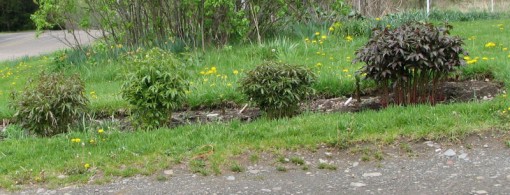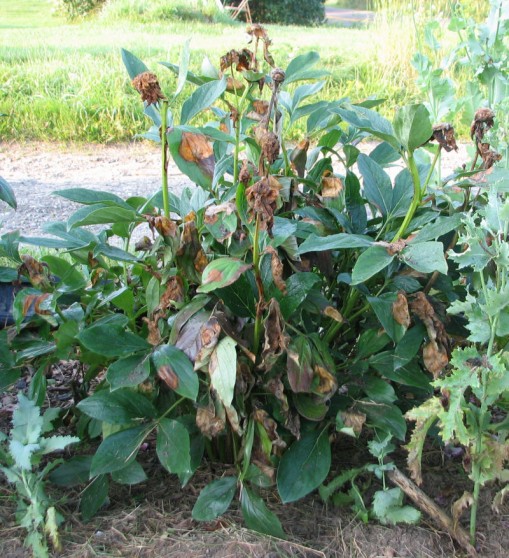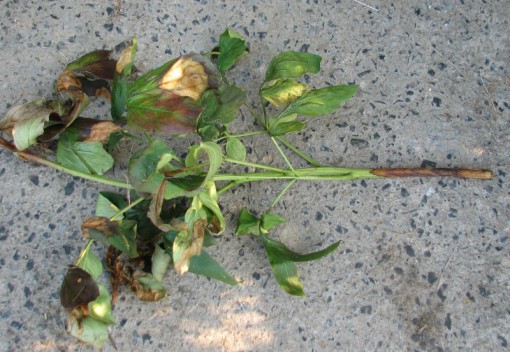This spring, I had the most beautiful peonies in the world.

I was especially taken with the foliage of ‘Bev,’ the one on the far right. It was a smoky purple. The flowers were spectacular, too, but I never managed to get a photograph this year. You can see them, here, though.
One of the reasons I never got around to taking pictures was that we had an awful lot of rain, culminating in record-breaking flooding in our area. Which is a major factor in how my poor peonies look today:

Rozella is a mess. And this is after the first cutting back that I did in an effort to contain the problem. Her companions have a brown leaf here and there, but poor Rozella had whole stems brown down to ground level.

With some plants, when they look this bad, you cut them right down to the ground, water and fertilize, and, presto-change-o! the foliage grows back looking good. But not with peonies. The leaves that peonies unfurl in spring are the only leaves they will grow for the season. And it is the leaves, of course, that bring nutrition to the root, which will produce next year’s stems and flowers. So you don’t really want to cut down all of a peony’s leaves (or-ahem-mow them all down with a lawn mower).
I figured I’d already cut out a third of her stems in an attempt to forestall further infection–to no apparent avail. I really didn’t want to cut any more than I had to. So it was time to figure out how to treat the problem. I already knew that botrytis was a common ailment of peonies, but I always thought it looked furry, like mold, and this just looked brown. I searched on those keywords, however, and came up with several sources of information–but no pictures. So I decided to consult an expert–R. Scott Reath, of Reath’s peonies, where Rozella came from. He promptly emailed back, and said
Your peony has botrytis which is a common fungal disease. It starts from spores(sclerotia) that overwinter on last years old infected leaves/plant parts and also from spores blowing in from outside the garden. It starts and spreads during wet weather.
It can be controlled by:
Removal of old leaves in the fall after they freeze and remove from garden
Dead head the flowers when they are done blooming
Removing diseased leaves when they appear
Keep the leaves as dry as possible- water the ground not the leaves, do not overcrowd plants, etc.
Protective fungicide sprays are very good at preventing it from starting but will not make diseased lesions healthy. Use a spray approved for ornamentals that controls botrytis. start spraying early when plants first start to emerge and often. The Cooperative Extension Service can help with a list of fungicides that are currently available and can be used on peonies in your state(area).Sprays may not be needed some years if the weather is dry. Most plants get some blight late in the season and are not bothered. Certainly Peonies have been around long before there where sprays for botrytis. Many people do not worry about blight but it can weaken plants if it hits early and several years in a row and is unsightly.
For your plant this year I would give it a protective spray to reduce the spreading as much as possible and this fall cut the stems and remove. Even a few green leaves going into winter is better than none.
It turns out I have been following his advice, but not consistently. Sure, I deadhead the blossoms–unless it’s been raining for three days straight. Yes, I clip the foliage and throw it in the garbage (not the compost pile) at the end of autumn–as long as we don’t get an early snowstorm. I’ve made even this half-hearted effort because I have noticed an occasional browned bud in the past, and suspected botrytis. The last few years have been dry, and probably that has kept the problem in check. But this year, when we haven’t been having rain, we’ve been having morning fog almost every day.
I’m going to try spraying the foliage with GreenCure, which is a potassium bicarbonate-based foliar fungicide. Potassium bicarbonate is supposed to work better than sodium bicarbonate (baking soda) as a fungicide, and, like baking soda, it is considered acceptable for organic food production. Also, it is produced by a local business, and I just happen to have a free sample. As a matter of fact, I called Peter Yeager, president of GreenCure, this morning, and he recommended I spray in the evening when it was cooler, so the solution wouldn’t dry off as fast. So after supper that’s what I’m going to do. I’ll let you know how it turns out.




Oh, that is so sad– and frustrating! I think with that much rain it would have been super hard to keep anything dry. Maybe next year you will have to buy them their own shelter from the rain! It’s actually been a little dry here so far.
Let us know how the spray works!
How disheartening, Kathy. Mr. Reath is correct, it is botrytis. I saw the same symptoms when I was working at a retail nursery in 2003, four springs ago. It was my first spring here after relocating to upstate New York, and I remember how cool and rainy it was during April, May, and June of that year. It was sickening to watch large healthy plants melting away daily. The plants were unsaleable and had to be put in a holding area until end-of-season sales started. Spraying is the only option. The fungal spores are long-lived and always seem to be omnipresent in the environment. Your plants are well sited and have plenty of air circulation but the constant rains this summer have trumped your efforts.
I liked your observation regarding the identification of fungus on plants – i.e. how the same fungus can vary its look on different plants. Yes, botrytis is usually fuzzy but not on peonies. As an FYI, powdery mildew classic symptoms are fuzzy white spots and patches on leaf surfaces, stems, and flowers, but not on hydrangea macrophylla types and hybrids. I used to work for a potted plant nursery that forced hydrangeas into early bloom for Valentine and Easter sales. Part of the growing regimen was a spray program to spray the undersides of the leaves to prevent the first outbreaks of pm.